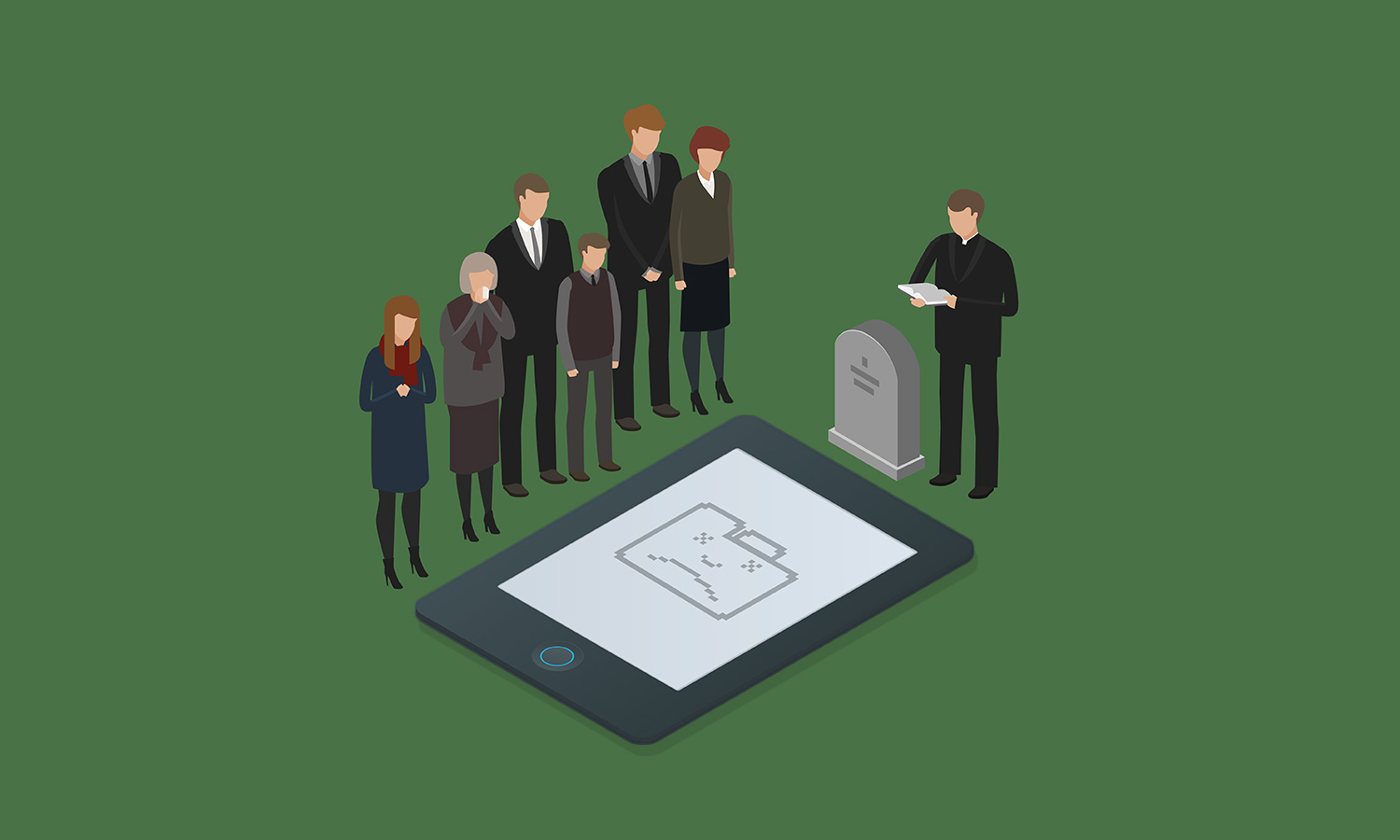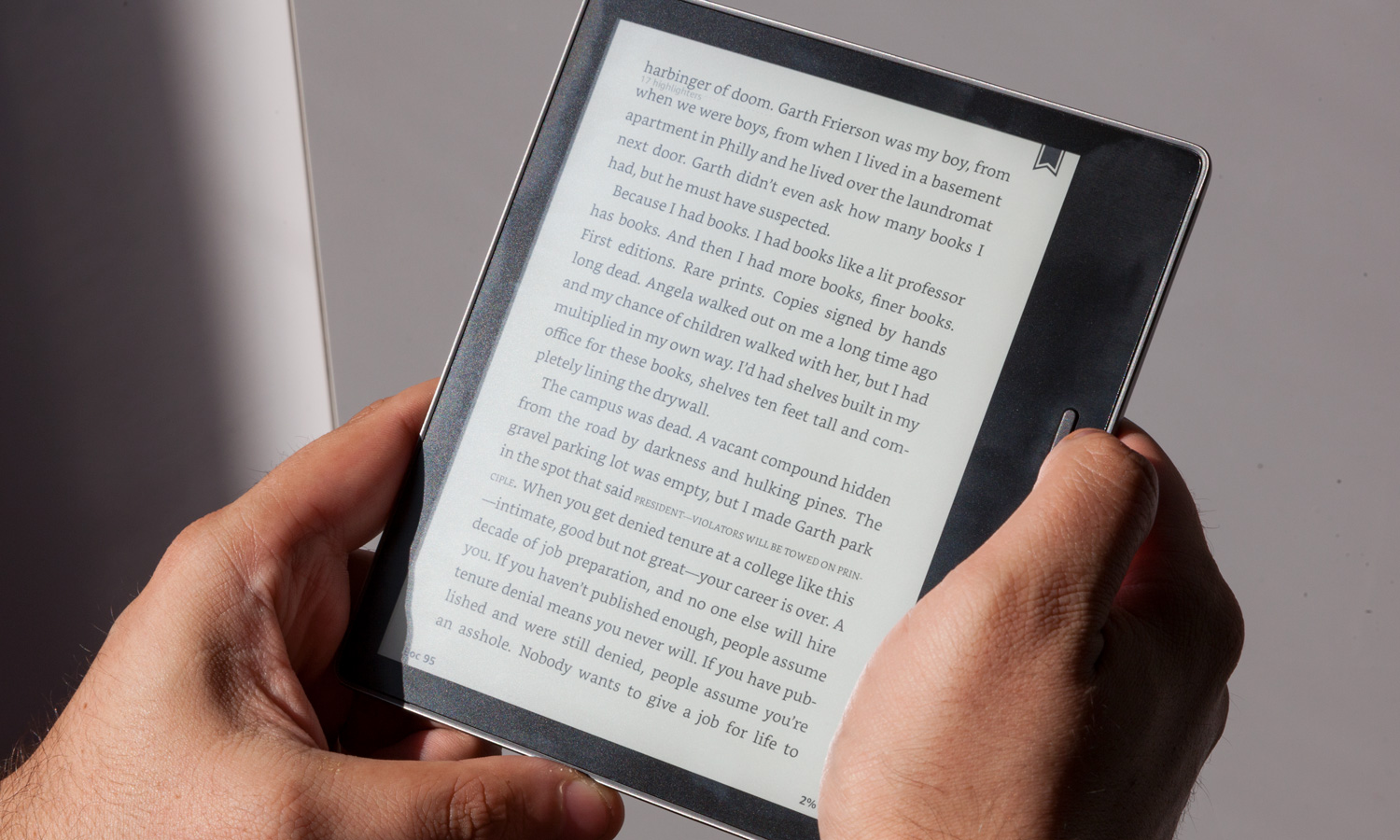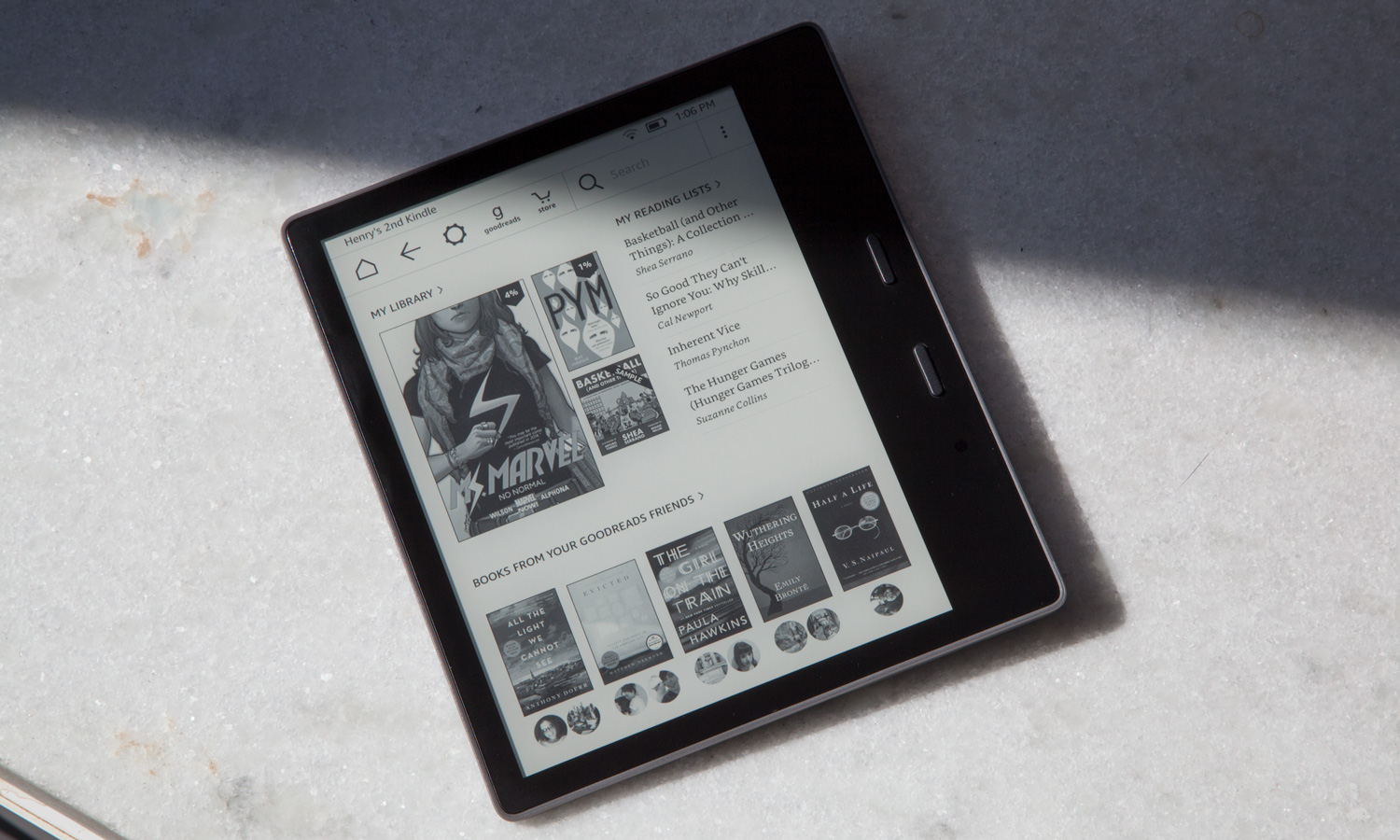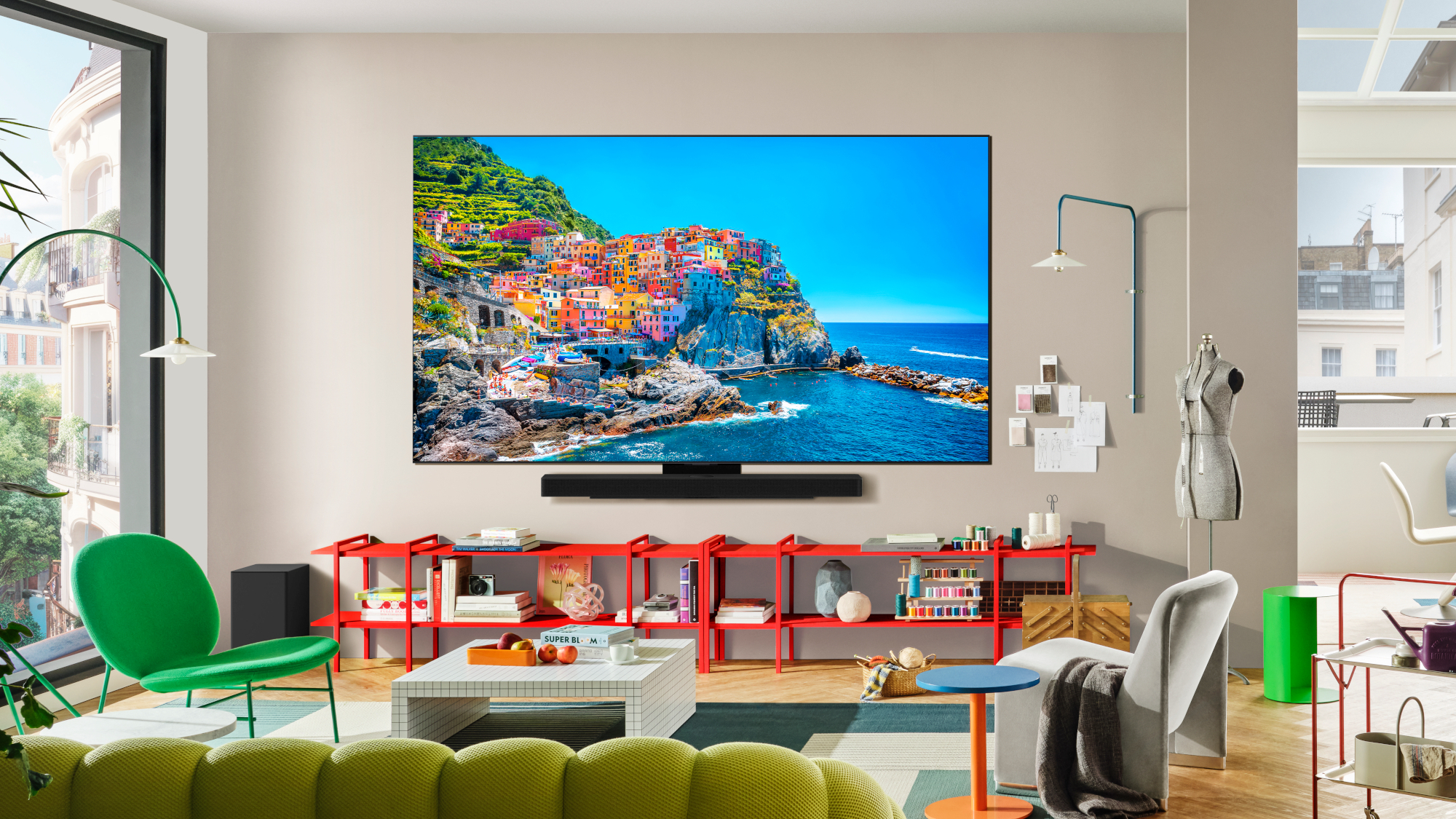Is the E-Reader Dead?
E-reader sales are in decline, but the real trouble for Nook and Kindle may be that we're simply not reading that many books.
Ah, the simple pleasure of a book. The slow burn of drama, the crisply printed words, the flash of the screen as you share a particularly moving passage on social media.

Yes, reading now is a little bit different than it was even a decade ago. While print books are doing surprisingly well, bigger and better smartphones have given e-books a second life. After 10 years of uncertainty, it seems that we finally live in a world where readers of both print and digital books can live in peace with each other. Neither one is going away anytime soon.
And yet, there may be a tragic undercurrent to this otherwise-happy story. While e-books are doing just fine, the fate of the devices dedicated exclusively to those e-books is much murkier. Even the best e-readers, like the Amazon Kindle and the Barnes & Noble Nook are much less widespread than they used to be — and arguably, much less necessary.
If you haven't looked up from your smartphone since 2007, you may have forgotten about the humble E Ink reader, also called an e-reader. Basically digital books, these devices use a technology called digital ink to simulate the look and approximate feel of a physical, paper-based book.
"The Kindle device is purpose-built for reading, so you can fully immerse yourself in an author's story. Kindle doesn't distract a reader with social media, emails and text messages," an Amazon representative told Tom's Guide.
Ten years ago, the Kindle was essentially the only game in town for e-books. But now, it's just as easy to read on your computer, your tablet, your phone — or even all three, thanks to cross-compatible apps. (It's worth noting, too, that the dangers of reading on LCD screens have been greatly exaggerated.)
In a world where convenience is king and delayed gratification is a dirty phrase, is there any room for a device that does only one thing and can't do that thing nearly as fast as the supercomputer in your pocket?
- Where to get free ebooks
Fewer readers, fewer e-readers
E-readers are catering to a diminishing audience. More than one-quarter of U.S. adults read no books in 2016; of the 74 percent who did, some read a single book "in part." The average U.S. reader finishes from four to 12 books per year, depending on whether you want to go with the median or the mean. The number of people who read, and the amount that they read, have both been steadily decreasing since the early '80s.
A few years ago, e-readers were more than just an exciting new innovation; they were also big business. For a brief period — 2011 to 2014, roughly — there was a real horse race among Amazon, Barnes & Noble, Sony, and Kobo in the e-reader market. Device sales soared, as did those for e-books.
Then, something strange happened: E-book sales more or less leveled off, but e-readers took a huge dive. In 2010, Amazon shipped 10.1 million Kindles — and the Kindle accounted for only 63 percent of e-readers shipped worldwide, meaning it had some legitimate competition. In 2011, Kindle shipments rocketed to 23.2 million. However, after a dramatic decline in 2012, and a steady decline ever since, Amazon shipped just 7.1 million Kindles in 2016.
MORE: Do Sleep Tracking Devices Really Work?
Hard numbers are more difficult to come by from Barnes & Noble, but the company's digital sales (namely, Nooks, e-books and all associated paraphernalia) declined 23 percent between 2016 and 2017. The company's Nook-related sales have decreased more than sixfold over the last five years.
The logical conclusion was that manufacturers had done their jobs too well. After all, e-readers aren't powerhouse devices. If you buy one, it could last for years, giving you no real reason to upgrade. However, data suggests that e-reader ownership dropped precipitously. People weren't just neglecting to buy new devices; they seemed to be actively ditching their old ones.

Only 19 percent of U.S. adults owned an e-reader in 2015, and the numbers didn't vary much by sex, location or age. Twenty-seven percent of affluent individuals surveyed owned an e-reader, and they were the most enthusiastic buyers by far. Compare and contrast: 68 percent of U.S. adults owned a smartphone in the same year, and 87 percent of affluent individuals did, according to data from the Pew Research Center.
Both Barnes & Noble and Amazon released new E Ink readers last year: the extremely pricey Kindle Oasis and the extremely mediocre Nook GlowLight 3. Neither product is really inventive enough to reverse the e-reader's fortunes, and it's not really clear where either company could go from here.
For what it's worth, Amazon doesn't seem concerned about the future of e-ink readers.
"Single-purpose devices that allow readers to get lost in a book are as relevant as ever," an Amazon representative told Tom's Guide. "In fact, this year, Kindle had its best sales day ever."
I spoke with a few employees at Barnes & Noble as well, but ultimately, the company couldn't comment on the issue.
Who still uses e-readers?
Neither Amazon nor Barnes & Noble shared sales data with me. To get a rough idea of how many people are still using e-readers, I went straight to the source: a real, live author.
Erica Kudisch is a New York City-based novelist, librettist and director. (In the interest of full disclosure, she also once cast me in a musical comedy based on Christopher Nolan's Inception.) Kudisch works with Riptide Publishing, a small operation that specializes in LGBT romances, but also dabbles in sci-fi, fantasy, Westerns and other genre fiction.
For Kudisch, at least, e-readers are an integral part of how her audience consumes books.
"I would say I sell as many books on Kindle as on all other formats combined," she said. "I sell about two-thirds [more] books in digital formats than I do in print." While she couldn't share hard numbers, Kudisch has access to very granular statistics, including who reads her books on Kindle e-readers as opposed to Kindle smartphone apps.
"There is definitely a future in online reading," Kudisch said. "Whether e-readers are the vehicle for it remains to be seen."
This won't surprise anyone who knows a thing or two about the history of e-readers. While you can buy pretty much anything on a Kindle or Nook nowadays, the technology was first and foremost the domain of romance novelists.
"I would say that romance readers are particularly voracious readers, and particularly voracious readers tend to economize their space," she said. (Her wife's grandmother is one such reader, with stacks of excess romance novels stored in a bathtub.)
Sci-fi and fantasy readers, too, Kudisch explained, play a part in the e-reader's continued survival.
"Sci-fi and fantasy books tend to be doorstoppers," she explained. "It's much easier to shove a doorstopper onto your Kindle."
Genre fiction also tends to be serialized, which again makes it a natural fit for a digital format. "It's easy to buy in bulk; it's easy to continue a series. I know some writers in [young adult fiction] who have had a much easier time continuing their series in digital than getting a print contract for the fourth or fifth book."
Intrusions from the real world
Real life also takes a toll on our ability to read for pleasure. Without going into excruciating detail, there is a lot of bad juju going down in the world today. In order to stay informed about said bad juju, socially conscious individuals feel like they have to stay glued to news feeds rather than best sellers.
"Conscientious people who read, and who want to retreat into other worlds, feel like they can't retreat into other worlds anymore," Kudisch said. "This one is stranger than fiction already.
"It's very difficult to have escapist reading when you have to keep up with political reading," continued Kudisch. "We are spending so much time fighting, it's difficult to spend time reading. … If readership is declining, blame politics. Blame the climate that makes us feel like we have to be plugged into Twitter during our reading time."

As readers choose to spend their time on social media, it creates a vicious cycle. If they don't read, there's no impetus for their favorite writers to put out new material. This, perhaps, won't have much effect on the James Pattersons and Stephen Kings of the world, but for lesser-known genre writers, readership and profit often operate on razor-thin margins. A few hundred people tuning into Twitter rather than the third book in your series may mean you'll never write a fourth.
"Let it not be said writers aren't having a difficult … time, too," Kudisch said. "I know so many people who let go of their products in 2017, just because the deluge of vitriol and depressing news actually makes it harder. … It's a case of mass media and social media cutting into an already finite day and an already finite brain space."
An uncertain future
Genre fiction, as we've established, is a key component in the e-reader's continued survival. This is especially beneficial for authors like Kudisch, whose books don't fall neatly into one genre or another. Kudisch described her second book, "Don't Feed the Trolls" — which focuses on a queer gamer who goes head to head with the developer of their favorite MMO, and also falls in love — as having an elevator pitch that's longer than the elevator ride.
"We carve out our space online, because there is no real space for people who write what we write," she said. "If you have to punk-zydeco-rockabilly your way through all of this and mention the weird, small subgenres, or say that your book has no genre at all, a lot of avenues are closed to you."
MORE: Kids Tablets to Buy (or Avoid)
One could argue that a smartphone or tablet would provide just as many opportunities for genre writers and readers to find one another, but remember: Kudisch's readers don't generally buy her books on smartphones. These customers buy her books on Kindles. Whatever their reasoning, the bottom line is that e-readers help customers find and experience books in ways that smartphones simply don't.
Although E Ink readers are the best way to experience an e-book, the outlook for the inventive technology is uncertain, at best. Readership is down; e-reader sales are down; e-book sales are down (albeit going slowly). As a culture, we seem to have decided that we just don't want to read books, and we certainly don't want to fork over another $100 up front to do so.
"There is definitely a future in online reading," Kudisch said. "Whether e-readers are the vehicle for it remains to be seen."
Illustration by Tom’s Guide; Shutterstock
Sign up to get the BEST of Tom's Guide direct to your inbox.
Get instant access to breaking news, the hottest reviews, great deals and helpful tips.
Marshall Honorof is a senior editor for Tom's Guide, overseeing the site's coverage of gaming hardware and software. He comes from a science writing background, having studied paleomammalogy, biological anthropology, and the history of science and technology. After hours, you can find him practicing taekwondo or doing deep dives on classic sci-fi.
-
The Paladin when you think about it, ereader sales slowing down as people keep them, switch to tablets with kindle or ecaliber software on them would likely be the answer, the real baseline is, are they selling just as many ebooks ?Reply -
matthew.maurer I think and hope there will continue to be a place for e-readers. Reading on a tablet or smart phone downright sucks. The glossy screens and glare are not conducive for long-time reading and can be a strain on the eyes. Much prefer my kindle.Reply -
michael.tuffli More power to you if you can read e-books w/ backlit screens w/o straining the crap out of your eyes, but I sure can't.Reply
/still keeps an e-reader around -
binder.saini There was always going to be a surge in the technology during the initial uptake. This has probably plateaued since people have become increasingly tech aware and the prevalence of cross-device reading apps has shifted the focus away from e-readers being the standard. Even so, the e-reader presents fewer distractions and allows you to focus on reading rather than being led astray by emails or social media.Reply -
manofcity1 You can buy Nook reader,not nook tablet,on Ebay ,for less than $100.00 all depends what it comes with,some sellers just want to get rid of them,you would be amaze how little they cost on Ebay,heck even Samsung Nook tablet is going for only $50 to $100.Reply -
USAFRet You'll have to pry my Kindle paperwhite out of my cold dead hands.Reply
Reading on a tablet or laptop is a far, far worse experience.
Sales might be "in decline", because they're pretty robust, and don't need replacing that much.
My paperwhite does exactly what it needs to do, no 'upgrade' needed.
And I use it every single day, 1/2/3 books a week.
It will only get replaced if it actually breaks. -
nduke E-readers aren't dead! I use mine every day and I have passed my old ones on, converting others to the platform. I like the e-ink page to read. I get a headache trying to read on my PC, tablet or phone for long periods and there are too many opportunities for distraction. E-readers are mostly a single use item and as such they don't wear out or require upgrades as often as a tablet or phone would. I just replaced a battery in my 2013 purchased Paperwhite and another in the one I bought for a friend in 2012. E-readers don't become obsolete like so many electronics because if they turn a page fast enough to read, they're fast enough. No upgrade needed. Believe me, if there wasn't enough profit in e-books, the e-readers would be built for obsolescence, the price would be lower and their sales would be up. I look at it as one less thing to send to the landfill.Reply
Edit: And I have to say that anyone who believes that e-readers are dead simply because device sales are down, must never have used one. I know some people who jumped on the e-book bandwagon late. They seem to feel that reading on their tablet is just fine. But for someone who likes reading and does so frequently, there is nothing to compare with a real e-reader. -
Sedivy While I'm on kobo and not an e-ink one, I still find dedicated e-reader too good to replace. Laptops and tablets are generally too big, unless a mini-tablet which is...pointlessly expensive in comparison to most e-readers. Phones are too small. E-readers are just right and configured for reading (lighting, specs, settings) which would be annoying to switch on a phone or laptop every time you wanted to do something else.Reply -
tamulawilcoxbeltonsawyer My first time .. using an ereader was the 3rd GenReply
Kindle Keyboard. I gave it to a family member as I gradually accumulated numerous Fires along with a Samsung Tab.
Then the Goldilocks of Kindles came along..the Paperwhite.
I'm not distracted with email or tempted to view YouTube.
I keep the brightness bar at the halfway point , so no eye strain.
It's true, though..they are made to last a long time, require very little maintenance and are simple to use.
Not a product many will replace yearly. -
throtol I recently purchased a Kobo Aura One. My original Nook (version 1) still functions and is a handy device. However, like all technology, it grows old. The page turns drag and the resolution is good, but not great. In addition, the size and weight of my Kobo Aura One is a fraction of the Nook.Reply
I can keep thousands of books on my device.
I do not like reading on a tablet and smartphone due to the strain. There are some blue light applications that improve the reading experience, but nothing beats my Kobo.

